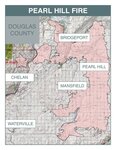


Living in the foothills of the Eastern Cascades we are all keenly aware of the danger and devastation of wildfire. Over the last month I have been inundated with press releases and information about wildfires and their effect on Washington state. The impacts go far beyond the costs of fighting the fires and the loss of private property when homes are destroyed.
As Senator Brad Hawkins has said, “the state has paid hundreds of millions in recent years reimbursing the costs of wildfires. And that does not even factor in the negative long-term economic impact that wildfires have had on communities in our district, including the impact on our all-important tourism or recreational opportunities. There are also emotional costs and losses that cannot be quantified, as courageous firefighters from our area have sadly lost their lives or been severely injured battling these blazes. Finally, there is a quality-of-life impact caused by wildfires, as smoke can blanket a region, making it dangerous for people to be outdoors and difficult for many to breathe.”
When fires are active and the valleys are filled with the smell of smoke we all have seen how tourists avoid our area. For communities like Chelan, Entiat, Leavenworth and Brewster the loss of revenue from the summer tourist season can make for a long winter.
According to Hawkins last year the Department of Natural Resources responded to 1640 fires. Those fires burned 813,000 acres, 400,000 of those or nearly half were in in Okanogan and Douglas counties. The Cold Springs and Pearl Hill fires destroyed over 100 homes. Add in the devastating fires in the back to back years of 2014 and 2015 in Chelan, Pateros, Entiat and Brewster and it is undeniable that our region has had more than its share of devastating wildfires.
In 2017, the legislature passed Senate Bill 5546 directing the state DNR to set up a framework for evaluating and treating fire-prone lands. That law sets specific goals for assessing and treating over 1 million acres over 16 years. The process will rely primarily on prescribed burning, previously called controlled burning, and strategic thinning.
Senator Hawkins and DNR Commissioner Hilary Franz admit that the effort to address the problem in high risk counties like Chelan and Okanogan will take more than a state program. They encourage all local residents to become actively engaged in developing Fire Wise programs in their communities.
For her part Franz has initiated a program called “Wildfire Ready Neighbors.” This six-week pilot program will have a staggered rollout in three high-risk counties that:
To join, community members simply sign up at www.wildfireready.com. At no cost to the community member, a wildfire expert will visit their property and develop a detailed action plan for wildfire preparedness. The plan includes steps they can take immediately and information about local resources and contractors to help get them started.
Wildfires often spark fires miles away. Fire officials say 90 percent of homes and buildings are lost as a result of wildfire embers blown by winds. Local residents may remember how fires were started in downtown Wenatchee by flames from a wildfire up in the foothills just a few years ago.
The Department of Natural Resources has encouraged landowners to be Firewise by taking steps to prepare the area around their home making it more defensible in case of a wildland fire. DNR claims studies show that 80 percent of the homes lost, as a result of a wildland fire, could have been saved if brush around the home had been cleared and a defensible space had been created.
Senator Hawkins and Commissioner Franz both admit that fire suppression efforts must become more aggressive. Too often in the past fires were allowed to burn until there was no way to put them out until a heavy rain or even snowfall ended it naturally.
Some of the programs being implemented by DNR provide financial assistance. For example, landowners up the Chumstick and Eagle Creek areas outside of Leavenworth can get financial assistance for approved programs to make their properties less prone to wildland fire. Small Forest landowners should contact the State Department of Natural Resources to see if they are eligible.
Comments
No comments on this item Please log in to comment by clicking here